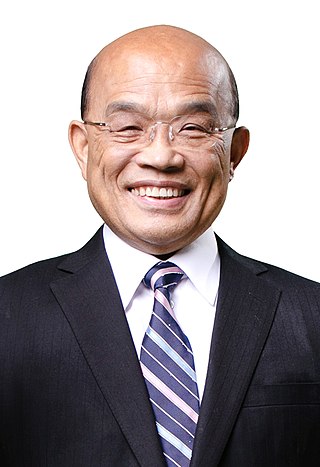
The National Assembly was the authoritative legislative body of the Republic of China, from 1947 to 2005. Along with the Control Yuan and the Legislative Yuan, the National Assembly formed the tricameral parliament of the Republic of China.

Xu Shichang was a Chinese politician who served as the President of the Republic of China, in Beijing, from 10 October 1918 to 2 June 1922. The only permanent president of the Beiyang government to be a civilian, his presidency was also the longest of the Warlord Era. Previously, he was Minister of the Cabinet of the Imperial Cabinet during the Qing Dynasty.

Su Tseng-chang is a Taiwanese politician who served as premier of the Republic of China (Taiwan) from 2006 to 2007 and again from 2019 to 2023. He was the chairman of the Democratic Progressive Party in 2005 and from 2012 to 2014. Su served as Chief of Staff to President Chen Shui-bian in 2004. He is currently the longest-serving Democratic Progressive premier in history.
In Taiwan, parliamentary elections are held every four years to elect the 113 members of the Legislative Yuan, the unicameral legislature of Taiwan. The current electoral system was introduced in 2008. The constitutional amendments of 2005 extended term length from three to four years, reduced seat count from 225 to 113, and abolished the National Assembly, originally another governmental organ equivalent to a chamber of parliament.
The Anhui clique was a military and political organization, one of several mutually hostile cliques or factions that split from the Beiyang clique in the Republic of China's Warlord Era. It was named after Anhui province because several of its generals–including its founder, Duan Qirui–were born in Anhui.

The 1918 Chinese National Assembly elections, held in May to June, were the elections for the second National Assembly. The bicameral assembly consisted of a senate and a house of representatives. Representatives were directly elected while senators were elected by provincial assemblies.

The 1911 Chinese provisional presidential election was the election held on 29 December 1911 during the Xinhai Revolution for the First Provisional President and Vice President of the Provisional Government of the Republic of China. Sun Yat-sen and Li Yuanhong were elected as President and Vice-President respectively. Sun swore in at midnight on 1 January 1912 and declared the official establishment of the Republic of China.

Taipei City Constituency I includes all of Beitou and part of Shilin in northern Taipei. The constituency is currently represented by Rosalia Wu of the Democratic Progressive Party.

The 1912 Chinese provisional presidential election were the elections held on 15 February and 20 February 1912 in Nanjing for the second provisional President and Vice President of China.

The 1913 Chinese presidential election were the election held on 6 and 7 October 1913 in Beijing for the first formal President and Vice President of China. The incumbent Yuan Shikai and Li Yuanhong were elected by two houses of the National Assembly.
The 1918 Chinese presidential election were the elections held on 4 September 1918 in Beijing for the second term of the President of China. Xu Shichang was elected by two houses of the National Assembly which were controlled by the Anfu Club formed in the National Assembly election in the same year.
The 1923 Chinese presidential election was the election held on 5 October 1923 in Beijing for the third term of the President of China. Zhili warlord Cao Kun won the election through bribery.

New Taipei City Constituency I includes districts along the northwestern coast of New Taipei City. The district was formerly known as Taipei County Constituency I (2008–2010) and acquired its present boundaries since 2008, when all local constituencies of the Legislative Yuan were reorganized to become single-member districts.

New Taipei City Constituency 5 includes all of Shulin, Yingge, and part of Xinzhuang in New Taipei City. The district was formerly known as Taipei County Constituency 5 (2008-2010) and was created in 2008, when all local constituencies of the Legislative Yuan were reorganized to become single-member districts.

New Taipei City Constituency 9 includes all Yonghe and part of Zhonghe in New Taipei City. The district was formerly known as Taipei County Constituency 9 (2008-2010) and was created in 2008, when all local constituencies of the Legislative Yuan were reorganized to become single-member districts.

New Taipei City Constituency 10 includes all of Tucheng and Sanxia in New Taipei City. The district was formerly known as Taipei County Constituency 10 (2008-2010) and was created in 2008, when all local constituencies of the Legislative Yuan were reorganized to become single-member districts.

New Taipei City Constituency 11 includes districts in southeastern New Taipei City. The district was formerly known as Taipei County Constituency 11 (2008-2010) and was created in 2008, when all local constituencies of the Legislative Yuan were reorganized to become single-member districts.

New Taipei City Constituency 12 includes districts along the northeastern coast of New Taipei City. The district was formerly known as Taipei County Constituency 12 (2008–2010) and was created in 2008, when all local constituencies of the Legislative Yuan were reorganized to become single-member districts.














